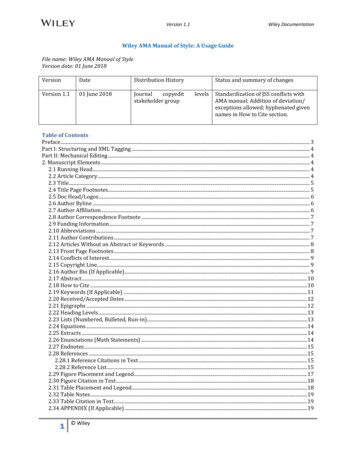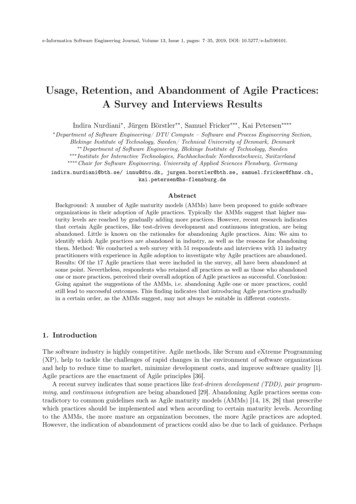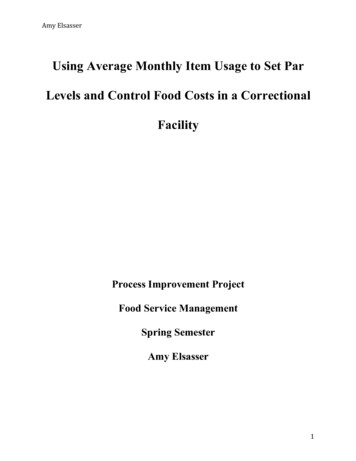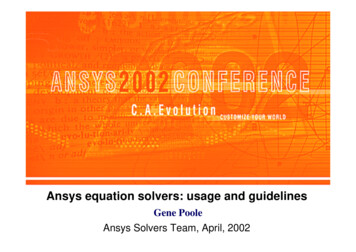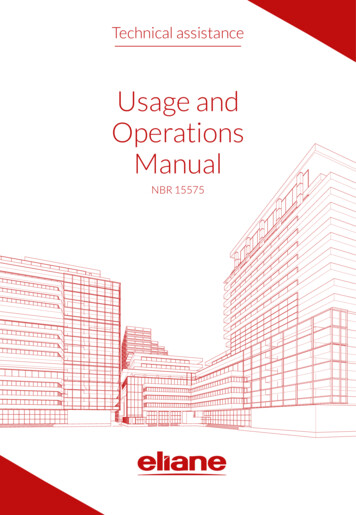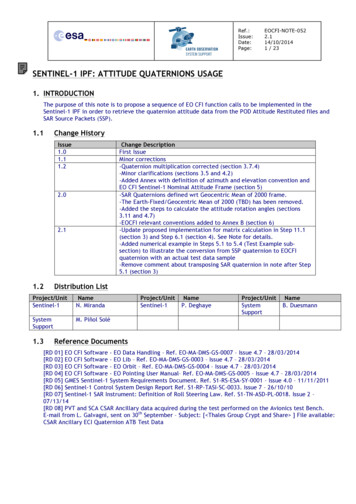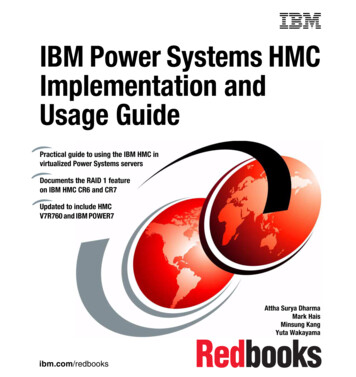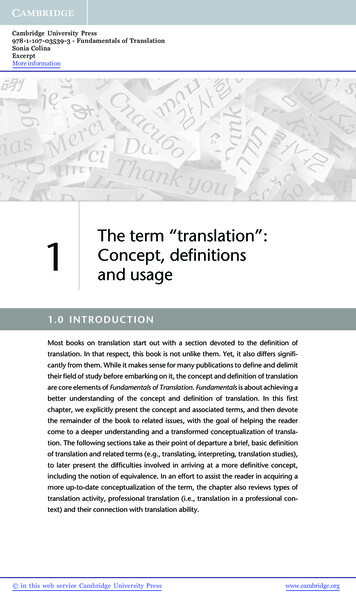
Transcription
Journal of Communications Vol. 15, No. 4, April 2020The Usage of CDN for Live Video Streaming to ImproveQoS. Case Study: 1231 ProviderWella Edli Shabrina, Dodi Wisaksono Sudiharto, Endro Ariyanto, and Muhammad Al MakkySchool of Computing, Telkom University, Bandung, IndonesiaEmail: wellaedli@gmail.com, {dodiws, endroa, ng is a popular technology used by activeusers for enjoying audio or video. Broadly, this technologyneeds high bandwidth to carefully keep its Quality of Service(QoS) at a reasonable level. Without enough bandwidth, aproblem arises, such as packet loss. This condition can decreasethe quality of content delivery. To properly handle that problem,cache technology can be utilized. One type of thesetechnologies is Content Delivery System (CDN). Naturally, theposition of CDN has to be placed not far from the user area, sothe access time can be faster than the access time when theCDN is not used. Another contributing factor, such as the rightvideo format selecting can provide a good impact. There aretwo popular formats for live video streaming, such as HLS(HTTP Live Streaming) and RTMP (Real Time MessagingProtocol). This study is going to elaborate on the comparativebetween HLS and RTMP with CDN and also without it. Theresult shows live video streaming with CDN has betterperformance than without CDN. Index Terms—Live video streaming, content delivery network,packet loss, HTTP live streaming, real time messaging protocolI.In notable addition, another contributing factor makesan impact on content delivery, and also its data loading inthe client is codec operation [2]. The codec is naturallyneeded for the video streaming concretion typicallyloaded by the user application. It is a critical aspectbecause the target user may employ a device that haslimited computation ability, such as a non-PC device.Presently, there are modern architectures use a familiarpattern like the cache function in proxy server. They areCDN (Content Delivery Network) and NDN (NamedData Network) [3], [4]. Even though the NDN isundoubtedly a new architecture related to how datacommunication is performed, CDN is a popularmechanism for video streaming up until now.For video data streaming, two practical methods can beexhibited. The first is on-demand, and the countless otheris live streaming [5]. Frequently, the live streamingmethod has a challenge relatively bigger than the ondemand method because the data delivery has to be donein real-time. So, maintaining related to the data deliveryhas to be executed with the latency level as small aspossible.For Indonesian people live modestly in foreigncountries, an instinctive desire to appreciate digitalcontent typically produced in Bahasa may remain arequirement. For that reason, The 1231 Provider tries toannounce a service such as broadcasting by performinglive video streaming with HLS (HTTP Live Streaming)or RTMP (Real Time Messaging Protocol). Thosestreaming protocols permit a significant quality of livevideo streaming to be sent instantly.However, when live streaming is performed, thelimited bandwidth factor can make the quality of videodelivery decreases. Another factor, such as the long-rangebetween the client and the server, creates a long delay forvideo data delivery. CDN can be properly utilized forvideo streaming to maintain QoS of content deliverycarefully. The stressing point is CDN position has to beas closer as possible to the target user location, so by thatway, the throughput created can be maximized.In addition, there are still a few Indonesia companiesthat have a core business in live video broadcasting thatuses CDN infrastructure. Mainly focusing on Indonesiancustomers live abroad, such as in California or Tokyo.In this study, there is a case that 1231 Provider, a localbroadcaster in Bandung, Indonesia, has no backboneinfrastructure, so the cloud infrastructure is a logicalINTRODUCTIONStreaming technology can be naturally used forenjoying standard audio or video content from certainproviders. Generally, to maintain the quality of thosecontents delivered, a channel operated has to require highbandwidth. The streaming via a line with limitedbandwidth has a risk because the channel can decreasethe quality of the contents sent. The academic field of acomputer network has identified possible mechanisms tomodestly increase QoS (Quality of Service) of thosecontents delivered. One of the mechanisms is by using acache [1].The cache is temporary storage to increase data accessspeed if the data are reused again [1]. Broadly, the cacheusage in the internet world is functioned when a specificuser does the surfing, and the functional is traditionallydone by a proxy server. Sometimes, this function of aproxy server has a problem when the data saved arebigger than the cache capacity. Frequently, it introduces adelay for video content transferred if the user tries tomaintain received data because the data cannot be cached[1].Manuscript received September 12, 2019; revised March 5, 2020.doi:10.12720/jcm.15.4.359-366 2020 Journal of Communications359
Journal of Communications Vol. 15, No. 4, April 2020choice for its successful operation. AWS (Amazon WebServices) is wisely selected because it is a popular cloudprovider, and the principal payment can be not asexpensive as if 1231 Provider itself builds the backbone.Besides cloud technology, 1231 Provider also exhibitsCDN, and both HLS and RTMP to increase videostreaming performance. Its clients are placed inCalifornia and also in Tokyo.II.for the first time. The proxy server is going to catch thatcontent into the cache instantly. So when another user isgoing to launch the same page (beforehand the cache isrefreshed), then the proxy server is going to serve thatpage. So, the content is going to be loaded faster than ifthe page is downloaded from the original site.2) Content delivery networkCDN is a group of nodes connected to each other andacts as content replication placed in strategically positionaround the world of the computer network. The contentcached can be a web page or video, including mediastreaming [5]. Related to its design, CDN has fourpurposes goals which are performance, reliability,scalability, and responsiveness [13].RELATED WORKSSome architectures can be used related to theconceptual of the cache, such as a proxy server, CDN,and NDN [3], [4]. In general, the popularity of CDN inpractical implementation for video streaming is higherthan NDN's popularity [4]. It happens because NDN isstill in progress to achieve its stable development [6].Invaluable addition, CDN is also popular because itsusage can minimize packet loss, as a possible result, itcan maximize throughput [7].The published paper of [8] recommends acomprehensive framework to compare NDN and CDNobjectively. It typically exhibits cache distributionperformed by CDN, or NDN demonstrates significantcontribution for QoS. However, the CDN can offer betterperformance slightly than NDN when the cache capacityneeded is large.In [9] presents RTMP player requires higher CPUpower than HLS player because RTMP operates on smallframes instead of large chunks, which leads tosignificantly higher processing overhead.The study of [10] exhibits HLS media server for multibitrate VOD service can increase storage and powerefficiency by using real-time transcoding according toclient request pattern.In [11] shows HLS is the most popular commercialprotocol. HLS can support live streaming for manydevices (in terms of maximum resolution or maximumbitrate can be supported by the devices) depends on thenetwork condition.The observation of [12] presents HLS has betterperformance than RTMP related to delay parameter.However, according to the small percentage of packetloss, RTMP works better than HLS.The RTMP is used as a basic protocol for comparisonbecause it can be stated as the first streaming protocolcreated by Macromedia (now Adobe). Based on theliterature above, this study examines live video streamingby comparing between HLS and RTMP for bothconditions (with CDN and without it). CDN is performedby exploring cloud technology provided by AWS (e.g.,AWS CloudFront). The parameters explored asperformance metrics are throughput and packet loss ratio.Authorize Report OriginCDNRequestFig. 1. The caching mechanism of CDNThe CDN mechanism is started when the clientrequests web content from an origin server. The server isgoing to respond to the client requesting by sending theweb content to the client. (Fig. 1)In addition, the origin server is going to produceduplications of the web content and forward them to theCDNs. Every content changing in the origin server, theCDN servers are going to update it in their cache storagesinstantly. Every CDN server can act as a content provider.However, the CDN server closest to the client positionhas a bigger chance of being the provider. Logically, thecontent is faster to be downloaded by the client than if theorigin site delivers it.A. The Cache Architectures on the Internet World1) Proxy serverThe proxy server is performed to save a web page tolocal cache from the internet temporarily. It happenswhen the user surfs on the internet, loads the web page 2020 Journal of CommunicationsDeliverFig. 2. The illustration of CDN servers360
Journal of Communications Vol. 15, No. 4, April 2020For example, since a client in Japan downloads contentfrom Indonesia, the request to the origin server can belonger than the request to the nearest CDN. It happensdue to the distance between the two countries. By usingCDN, the requested content place is not as far as to theorigin site (located in Indonesia), but it is located in theclosest CDN server (located in Japan). (Fig. 2)3) Named data networkingNamed Data Networking (NDN) is a new networkarchitecture. The NDN packet carries the data name(Name), not the source address or destination address(e.g., IP address). NDN is intended to replace the hostcentric into data-centric architecture [3]. In NDN, the IPaddress is replaced by Name (data name), and for datacommunication, NDN uses two types of packages:Interest and Data. Both Interest and Data carry a Name toidentify data uniquely. The node requests Data is calledas Consumer. On the other hand, the node replies therequest is determined as Producer [3].B. Feature Comparing between Proxy Server and CDNfor Caching FilesThere are disabilities owned by the proxy server, andCDN can handle them. The first disability is related to itsscalability. The proxy server only covers the local areanetwork. On the other hand, CDN projection can be aswide as a wide area network. The CDN cache capacity islarger than the proxy server cache capacity. Consequently,CDN can handle the weakness of the proxy server, suchas caching large files (e.g., video files). CDN alsosuitable for the application needs authentication feature,while the proxy server cannot execute that feature.By using large cache capacity, CDN can reduce thelatency of data streaming, or it can be said that CDN canincrease the throughput of data streaming. This conditionalso happens because CDN distribution can cover a largearea network. As a result, the CDN position serves theclient request can be the closest one.Sometimes, CDN can be called as Reverse Proxy. Bythis operation, CDN is going to cache the contentautomatically from the origin server. This content isgoing to be loaded by another client when there is a nextrequest related to it.C. The Streaming Mechanism of HLS and RTMPRelated to CDN ImplementationThe HLS format strives to maintain video qualityduring the streaming session. The video streaming sent isgoing to be encoded and divided into several segments.Each segment is stored in storage or buffer alternatelyduring the streaming period. However, on the client-side,the sized content in each segment is dynamically adjustedto the ability of the player to display the streaming video[14].The RTMP format is going to divide the video streaminto fragments, and the size of each fragment candynamically change. It depends on the connectionconditions between the client and the server. However, 2020 Journal of Communications361fragment sizes are generally fixed. If the bandwidthdecreases to under the lowest limit of the bandwidth sizerequired for content delivery, the client player is going tobe continuously interrupted [14]. There is no additionalfeature to maintain the bitrate of the content received bythe player likes in HLS format.When the CDN is utilized, the impressive performanceof streaming video sent can be further improved. It isrelated to the notable features of the service protocol thatsupports HLS and RTMP, namely TCP (TransmissionControl Protocol). TCP has several features, which areflow control and retransmission. The mechanism ofcontent duplication on CDN makes the distance betweenserver and client is as though reduced. The contentduplicated from the original site is going to be placed atthe nearest CDN location to the client. So, when theclient requests the content, the content deliverymechanism no longer needs to retrieve from the originserver can be farther away. Regarding the flow controlfeature, this condition can reduce the value of RTT(Round Trip Time) [15].The existence of the CDN also accommodates clientrequests. So that, it can reduce the traffic requests to theserver. Logically, this condition can improve serverperformance by avoiding server failure due to too manyrequests. According to the retransmission feature, if thereis a packet sending failure, the retransmission of thepacket can be directly served (in part or whole) by theCDN located closest to the client. This operation makesthe number of packet loss can be reduced, and it also canincrease the throughput automatically [15].D. Amazon Web ServicesAWS is a cloud service platform that proposesresources such as computation, database, content storage,content delivery, and any other functionalities to supportbusiness or organization oper
B. Feature Comparing between Proxy Server and CDN for Caching Files There are disabilities owned by the proxy server, and CDN can handle them. The first disability is related to its scalability. The proxy server only covers the local area network. On the other hand, CDN projection can be as wide as a wide area network. The CDN cache capacity is
